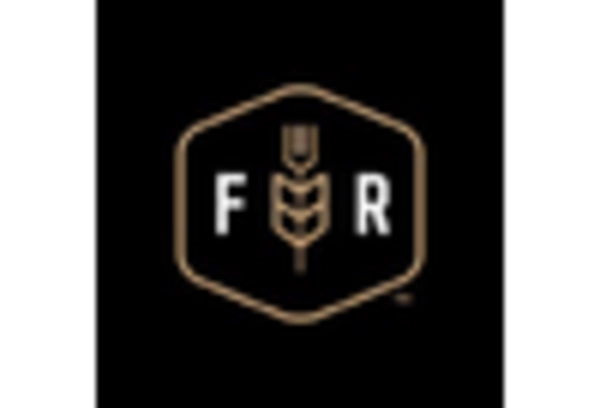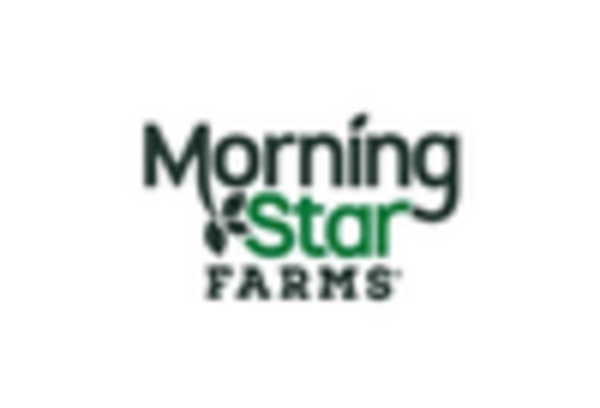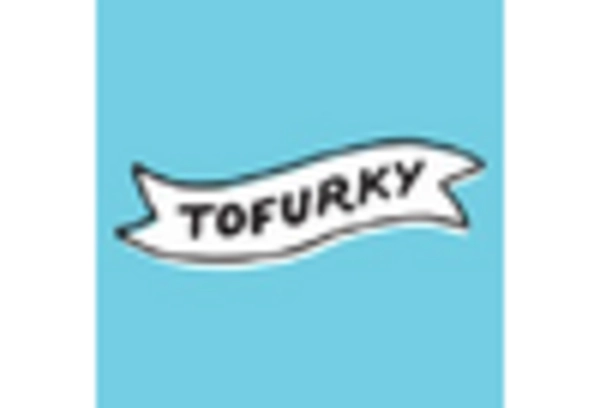Increasing Demand for Plant-Based Proteins
The meat substitutes market is experiencing a notable surge in demand for plant-based proteins, driven by a growing consumer preference for healthier dietary options. Research indicates that approximately 30% of consumers in the US are actively seeking to reduce their meat consumption, leading to a significant shift towards plant-based alternatives. This trend is further supported by the increasing availability of diverse protein sources, such as pea, soy, and lentils, which are being incorporated into various meat substitute products. The meat substitutes market is thus witnessing a transformation, as brands innovate to meet this demand, offering products that not only mimic the taste and texture of meat but also provide nutritional benefits. As consumers become more aware of the health implications associated with meat consumption, the market is likely to continue expanding, with projections suggesting a compound annual growth rate (CAGR) of over 10% in the coming years.
Technological Advancements in Food Production
Technological advancements are playing a crucial role in shaping the meat substitutes market, enabling the development of innovative products that cater to evolving consumer tastes. The industry is witnessing the emergence of new food technologies, such as fermentation and cellular agriculture, which are enhancing the quality and appeal of meat alternatives. For instance, companies are utilizing precision fermentation to create high-quality proteins that closely resemble animal products. This innovation is not only improving the sensory attributes of meat substitutes but also expanding their nutritional profiles. The meat substitutes market is thus positioned for growth, as these advancements may lead to a broader acceptance of plant-based products among consumers who are traditionally meat-centric. As technology continues to evolve, it is anticipated that the market will see an influx of novel products, further diversifying the options available to consumers.
Shifts in Consumer Lifestyles and Eating Habits
The meat substitutes market is being shaped by significant shifts in consumer lifestyles and eating habits, particularly among younger demographics. Millennials and Generation Z are increasingly adopting flexitarian diets, which emphasize the inclusion of plant-based foods while allowing for occasional meat consumption. This trend is reflected in market data, indicating that nearly 40% of younger consumers in the US identify as flexitarians. The meat substitutes market is capitalizing on this shift by offering a wide range of products that cater to these evolving dietary preferences. As consumers seek convenience and variety, brands are introducing ready-to-eat meals and snacks that incorporate meat alternatives, making it easier for individuals to integrate these options into their daily routines. This evolving landscape suggests a promising future for the market, as it aligns with the changing dynamics of consumer behavior.
Environmental Awareness and Ethical Considerations
The meat substitutes market is significantly influenced by rising environmental awareness and ethical considerations among consumers. Many individuals are increasingly concerned about the environmental impact of traditional meat production, which is associated with high greenhouse gas emissions and resource depletion. Reports suggest that livestock farming contributes to nearly 14.5% of global greenhouse gas emissions, prompting consumers to seek more sustainable alternatives. The meat substitutes market is responding to this shift by promoting products that are perceived as more environmentally friendly. Brands are emphasizing the lower carbon footprint of plant-based options, which can be up to 90% lower than that of conventional meat. This growing consciousness is likely to drive further innovation and investment in the sector, as companies strive to align their offerings with consumer values and preferences.
Influence of Social Media and Marketing Strategies
The meat substitutes market is increasingly influenced by social media and innovative marketing strategies that resonate with consumers. Platforms such as Instagram and TikTok are becoming vital channels for brands to engage with their audience, showcasing the versatility and appeal of meat alternatives. Influencers and food bloggers play a significant role in shaping consumer perceptions, often highlighting the culinary potential of plant-based products. The meat substitutes market is leveraging these platforms to create visually appealing content that emphasizes the taste and quality of their offerings. This marketing approach appears to be effective, as studies indicate that social media exposure can lead to a 20% increase in consumer interest in plant-based options. As brands continue to adapt their strategies to the digital landscape, the market is likely to see sustained growth driven by enhanced consumer engagement and awareness.

















Leave a Comment